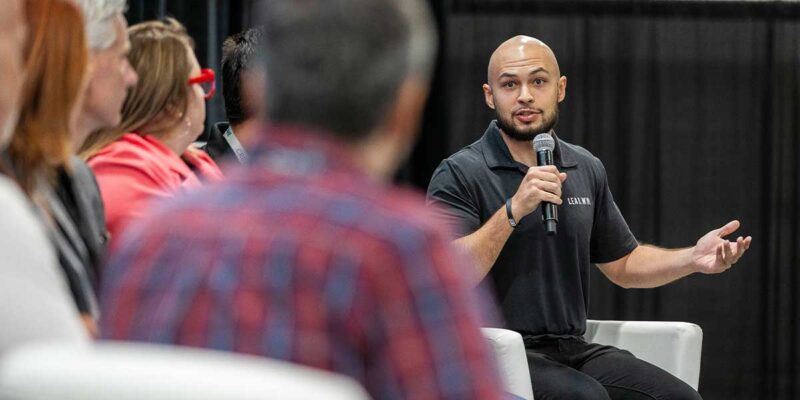InfoComm: Finally, Unified Communications and Collaboration for All
By Cindy Davis
InfoComm international
 Until fairly recently, when technology managers got a request to set up videoconferencing and collaboration systems, the options were separated by a chasm of options and price. At one end were very expensive, immersive telepresence rooms offering the highest quality audio, video and collaboration technologies to enable remote meetings. At the other end of the spectrum, options were limited to a handful of companies offering a bridge that enabled a video connection via the web, and the ability to share slide presentations, and often a dial-in connection for voice with a static image of the presenter.
Until fairly recently, when technology managers got a request to set up videoconferencing and collaboration systems, the options were separated by a chasm of options and price. At one end were very expensive, immersive telepresence rooms offering the highest quality audio, video and collaboration technologies to enable remote meetings. At the other end of the spectrum, options were limited to a handful of companies offering a bridge that enabled a video connection via the web, and the ability to share slide presentations, and often a dial-in connection for voice with a static image of the presenter.
A Sea Change
“The industry has expanded dramatically,” says Carol Zelkin, Executive Director of the Interactive Multimedia and Collaborative Communications Alliance (IMCCA). In the beginning, there was straight audio conferencing and there was videoconferencing. Videoconferencing leaned more towards room systems, “those big beautiful $250,000 conference rooms,” says Zelkin. “Now it’s a combination of audio, video, web: It’s a desktop, it’s a roll-about, it’s in the hospital being wheeled into a patient room, it’s in a classroom, it’s people working from their home because they don’t go into the office every day.”
At June’s InfoComm 2014 show in Las Vegas in June, there was a shift in the demographic of attendees to include a significant number of end-users from every vertical market. With its roots firmly planted in AV, InfoComm show attendees have been almost exclusively AV industry professionals comprising consultants, designers and integrators. In particular, this year saw a significant number of technology managers attending the show to learn about products and services being marketed directly to end-users. The Unified Communications and Collaboration Pavilion as well as educational sessions co-produced with the IMCCA were major drivers attracting more end-users than in previous years.
The “AV and IT and How it Works Together” session was sold out before the show started. “What people are realizing is that AV, IT, UC — everything has to work together for the customer,” says Zelkin. “The customer can be the vice president of conferencing for [a worldwide bank] and his customer is his end-users internally, but they are still customers and it all has to work seamlessly.” The end-user doesn’t want to know how it works — just make it work.
The New Customer
“What we saw this year — it’s not even the industry saying it’s changed, it was the end user,” says David Danto, director of emerging technology for IMCCA, and principal consultant of AV, multimedia, telepresence, UC, video for Dimension Data. It is clear that end-users are taking ownership of the UC space now. Danto is proud that IMCCA is an organization that represents the good for this industry. “We’re now presenting the educational pieces at the [InfoComm] show. They were very well attended and very high quality presentations,” says Danto. “It’s a real tipping point for the industry.”
After InfoComm, Danto spoke with a number of exhibitors who were remarking about the significant increase of the end-users at the show. “They all said the same thing: ‘We had really good users at the show, who were asking really good questions, and none of them were about, ‘how fast?’ or ‘how much bandwidth?’ or ‘what’s the resolution?’ It was ‘how do we make this work, what’s the user experience like?’” says Danto.
The user is evolving. Citing higher education as an example, “The AV guys have their place in the world because a lot of customers have very unique requirements they need a lot of custom build outs,” says Angie Mistretta, IMCCA board member, and director of collaboration endpoints solutions marketing at Cisco Systems, Inc.
Large spaces, such as auditoriums, lecture halls and multi-purpose spaces, will always need the expertise from AV consultants and integrators. Video and collaboration technology just becomes one component of a much larger thing. “What we’re seeing now is the companies that have that kind of need, but don’t have the kind of budgets that they maybe used to, or don’t have the budgets to enable a lot of rooms like that,” says Mistretta. “They’re looking for more plug-and-play solutions that deliver the same amount of impact, but just kind of in a different way.”
It used to be that every space within a facility was a custom job. “There were five, six, seven devices, a custom control program and more that made up a collaboration system,” says Danto. “But the failure rate is because of those disparate components. And the expense of those systems is margin and manpower putting those components together.”
Mistretta sees the move towards IT as a positive for AV guys. “Customers are asking for complementary solutions that are outside of the boardroom” to spaces such as the desktop, where AV guys typically don’t go. When AV guys think about their customers there’s a lot of opportunity for them to add more value by being able to broaden their scope and “think about the holistic view of the customer,” says Mistretta. Being able to pair mobile devices with an endpoint or provide cloud services can add more value into accounts.
“There is a lot that has changed our industry. The AV people, the dealers and reps all have to learn about it because their customers are asking for it; whether it is services or hardware,” says Zelkin.
With many more options available, from all-in-one endpoints, to cloud-based virtual meeting rooms, the cost of unified communications and collaboration systems have come way down. The systems have also become easy to install and use, in some cases needing little training. This is putting the decision-making power truly in the hands of the end-user/technology manager.
Danto suggests, “The tipping point is going to be where it’s no longer going to be people spending tens-of-thousands of dollars per room.” Instead they are asking, “What’s the experience? Do I really need to have a touchpanel with my company’s logo on it, did I need to pay $10,000 for the programming — or does the stuff that comes with [stand-alone appliances] — is it good enough?” We’re finally starting to see a real focus on the end-user. “The end-user themselves coming out for themselves, saying this is what we want, this is how it works; it’s a very refreshing change,” says Danto.
Beyond the Conference Room
With the rise in telecommuting, the IMCCA has been receiving more calls asking what home workers need in order to conference from home because they are realizing the need for video. “God bless Skype. I think there’s a wonderful time and use for Skype, but people understand that as a day-to-day business, that Skype is not the way you are going to conduct a two- or three-hour business conference,” says Zelkin. The use of conferencing has reached the masses. “We can really thank our friends at Cisco, for helping to create the awareness with the telepresence and conferencing commercials,” she says, while also crediting Skype for introducing the world to video.
“Communication and collaboration is everything. It is not just that conference room experience,” says Danto. Having the ability to collaborate and pick up discussions via different devices, such as PCs, tablets and phones has become important. “Now we’re looking at the space in a holistic sense. Its kind of moving it from the facilities world into the collaboration world.”
Danto feels that looking at huddle rooms in addition to large conference rooms is a great idea. “I think the industry has built too many big rooms for too many senior people,” he says. Real or not, there is a perception in some companies that the big conferencing rooms were made for just four or five senior people to use, making them off-limits to the majority of the staff. “More smaller rooms with less features, as opposed to bigger rooms that are very expensive, are definitely the right direction to be going in.”
In a “greenfield circumstance,” Danto says that 80 to 85 percent of rooms can be covered with off-the-shelf products where you don’t need any complex integration. “Drop it in, maybe an hour of assembly or an hour of install; then you got a collaboration system from the smallest to the biggest,” says Danto. There will always be the cases that you can’t cover with some off-the-shelf products when you are trying to ask it to do the uncommon thing. “That’s where you need a good AV integrator and AV consultant/designer,” says Danto. However, he suggests that a good AV integrator will also walk into a conference room that has a table with just a few chairs and suggest an all-in-one system and not make it into a custom job.
Lead With People, Not Technology
Where to start? It’s not with the technology. “You can get lost in the maze of technology. The shopping for and looking for the technology first is the worst way to approach the space,” says Danto. “Put all of that aside and start with the actual end-user experience — the use-case. How do you create a unified communications experience that works across the spectrum of who your users are?” says Danto.
Danto suggests starting by creating a user segmentation plan. “You have senior executives and admin assistances, office people, traveling people and you have operations folks,” says Danto. “There is not one tool that meets all those needs.”
Danto uses an assessment tool called the Unified Communications Development Model. It asks individuals in an organization their opinion of what they have, where they are now, and where they want to go. “Then we help build a road map to get there,” says Danto. “We do that assessment with the IT team; we get one set of answers. We put the IT team sitting in the back of the room and we bring in the actual business end-users, and do the exact same assessment, the exact same company at the exact same time, and we a get a completely different set of answers.”
“What typical IT people believe is happening and what’s actually happening in the minds of people — that’s a missed connection,” says Danto. The solution is simple. “Listen and hear what the problems are, and solve the problems.”
From there, you can start to access your real needs and determine where technology can help the collaboration process.
Danto says that the UCC community has a mantra: “Unified communications isn’t something you can buy; it’s an outcome.” It’s what happens when you plan infrastructure and consumption model, technology and people, use case and experience, and wrap it all together. “Then all of a sudden everything grows and it becomes unified communication,” says Danto.
Is the Future Now?
Is it possible that in three years we’ll look back at this being the time that dial plans for collaboration and conferencing will have gone away? “Everybody is moving to a virtual meeting room environment. The scale for that is tremendous. You could have a 200,000-to-300,000-person organization and everybody has their own meeting room, just like they have their own audio conference space. It is now actually achievable and there are firms doing it,” says Danto.
“The best way to put it: It’s for the common man. It’s for everybody,” concludes Zelkin.
This column was reprinted with permission from InfoComm International and originally appeared here.





